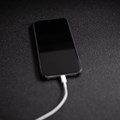Buying chargers
Counterfeit chargers can be deadly.
We tested a range of fake chargers and found that 98% of them had the potential to cause a lethal electric shock or start a fire.
With that in mind, it's important to be aware of the risks when buying a charger.
The 3-point safety check
Plug pins
- Check that there is at least 9.5 mm between the edge of the pins and the edge of the charger (9.5 mm is about the width of a ballpoint pen). If the distance between the edge of the pins and the edge of the charger is less than 9.5 mm, there is a risk of electric shock when plugging in and unplugging the charger from a socket.
- Plug the charger into a socket but don’t switch it on or connect it to your appliance.
- Does it plug in easily? If the charger does not easily plug into a socket, the pins may be the wrong size or length, or the distance between the pins may be wrong. If pins do not fit properly into the socket, overheating, arcing and mechanical damage can occur to both the socket and the charger, which can be dangerous.
Markings
- Look for a manufacturer’s brand name or logo, model and batch number.
- Check for a CE mark
- Check that the output voltage and current ratings marked on the charger and your electrical device are the same.
- Do not rely on a CE mark alone as a guarantee of safety – it’s simply a declaration by the manufacturer that the product meets all the safety requirements of European law, but they can be easily forged.
Warnings and Instructions
- Adequate warnings and instructions must be provided. As a minimum, user instructions should provide information on conditions and limitations of use, how to operate the charger safely, basic electrical safety guidance and details of how to safely dispose of the charger when it is no longer required.
For guidance on e-cigarette chargers click here.
For guidance on USB chargers click here.
For guidance on mobile phone chargers click here.
For guidance on laptop chargers click here.
For guidance on tablet chargers click here.
For further guidance on safely shopping for chargers and other electrical items, please read our Safe Shoppers Guide.

How to spot a fake Apple charger
Our handy guide will tell you everything you need to know to spot the differences between a genuine and fake Apple iPhone charger
Statistics and facts
- 1.8 million phone chargers are bought online in the UK each year.
- Unsafe devices are often made in China for as little as 3p, which means poor quality components. Sometimes these products don't have safety features such as fuses.
- The UK has seen a six-fold increase in the number of counterfeit electrical goods seized over the previous four years.
- The value of counterfeit goods seized by councils and the Border Control rose from just over £2.6 million in 2009 to more than £15.7 million in 2012. The most-seized items were chargers.
- A genuine Apple charger contains over 60 individual components, while a counterfeit contains an average of just 25.
Many imported chargers do not satisfy UK safety regulations and can cause serious electric shock, injury or fire.
Suppliers and retailers have a legal duty to ensure that all electrical equipment they sell is safe.

